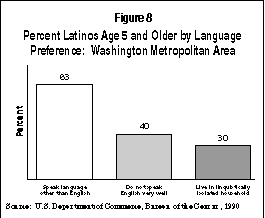Washington, D.C., Metropolitan Area
Latino Community Profile
Population Statistics
The number of Latinos residing in the Washington, D.C., metropolitan area has increased dramatically. Between 1980 and 1990, the percent of Latinos in the area doubled-increasing from 3 to 6 percent of the total population. The greatest change occurred in northern Virginia, where the population shifted from 3 percent Latino in 1980 to 7 percent Latino in 1990. During the same time period, the District of Columbia experienced a decrease in its overall population, while the number of Latino residents increased from 3 percent of the population in 1980 to 5 percent in 1990 and subsequently has emerged as the city's largest cultural and linguistic minority. Figure 1 shows the percent of the metropolitan area's population who are Latino, comparing 1980 and 1990 census data.

Areas of Concentration
Latinos are most heavily concentrated in two suburban areas of Washington, D.C.-Montgomery County, Maryland, and Fairfax County, Virginia. Figure 2 gives the percent of the Latino population residing in these locations.

Origin
A majority of Latinos living in the Washington metropolitan area come from Central America-with the largest group coming from El Salvador (23 percent). The next largest groups (14 percent each) are people of Mexican origin and individuals who identify themselves as Hispanic but are not of Central American, South American, Mexican, Puerto Rican, Cuban, or Dominican origin (noted as Other). Figure 3 portrays the area's Latino community by country of origin.

Age
In the Washington metropolitan area, the median age of Latinos is 26.5 years for males and 28.4 years for females. The median age for Latinos of both sexes residing in this area is 27.4 years-approximately 5 years younger than the median age for the U.S. population at large. Figures 4 shows the distribution of Latinos by age group.

Education
Thirty-six percent of adult Latinos in the Washington metropolitan area have less than a high school education, and 19 percent have a high school education. As shown in figure 5, about 45 percent have at least some college, and 23 percent have earned a bachelor's or advanced degree.

Occupation
In the Washington metropolitan area, more Latinos work in service occupations than in any other capacity. This category includes individuals who work in private households as well as those who work for businesses. Forty-four percent of Latinos in the work force hold professional, managerial, or technical positions. Figure 6 shows the percent distribution of labor by job category.

Income
The income of most Latino households in the Washington metropolitan area is in the low to middle range. As shown in figure 7, 14 percent live below the poverty level, and only 5 percent of Latino households have incomes of more than $100,000 per year.

Language Preference
About 83 percent of Latinos in the area speak a language other than English, and 40 percent do not speak English very well, as shown in figure 8. About 30 percent live in households that are linguistically isolated because no one in the home, age 14 or older, speaks English sufficiently.

NHLBI Information Center
P.O. Box 30105
Bethesda, MD 20824-0105
(301) 592-8573
Latino Resources
Home | Public Information
Information for Health Planners |
NHLBI Home








